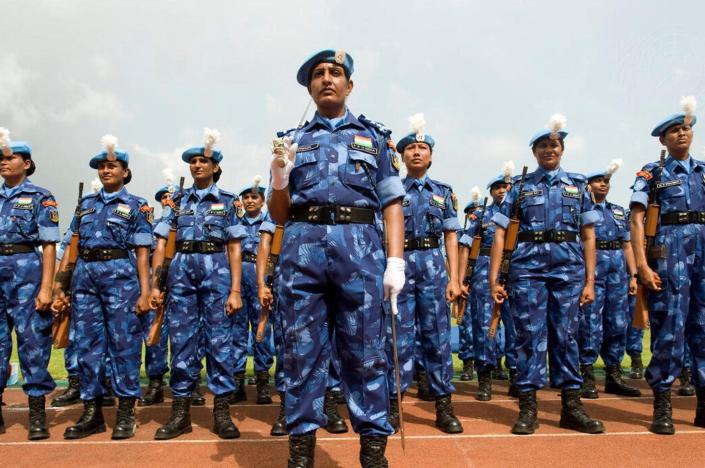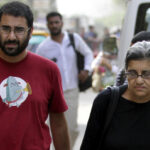The United Nations has about 74,000 peacekeepers in uniform stationed in a dozen conflict zones around the world. It’s easy to spot them in their signature light blue helmets. It’s harder to find a woman among them.
There are military experts, police and infantry units who come from 121 countries to help maintain peace.
Just 8% of peacekeepers are women.
This is a significant increase from 15 years ago – when the number of peacekeepers was about the same as today but women made up only about 2% of the ranks. For 20 years, the U.N. has been trying to improve this statistic.
But the U.N.‘s long-term goal of having as many female peacekeepers as men may well be unachievable.
As a U.S. diplomat and an international affairs scholar, I have been involved in peacekeeping in Africa, Latin America and the Middle East. While dramatically increasing the number of female peacekeepers has clear benefits, including improved community relationships, the evolution of peacekeeping makes gender parity impossible.
What the UN calls for
The U.N. does not have its own military. So when the U.N. launches a peacekeeping mission, it must ask its 193 member countries to provide the personnel necessary to staff it.
The U.N. pays countries a bit over US$1,400 a month for each soldier loaned to the organization. This can help poorer countries maintain their armies and pay their soldiers. Bangladesh, Nepal, India and Rwanda give the most soldiers to serve as peacekeepers, with over 5,000 people each. The U.S. currently provides only 30 staff officers.
In 2000, the U.N. Security Council recognized the gender imbalance in peacekeeping when it approved Resolution 1352, which urged that women be given more opportunities to serve. In 2018, the U.N. began specifically instructing its peacekeeping missions to work toward including as many women as men.
Research shows that including women in resolving conflicts is a good idea, especially since they are frequently the victims of war more often than men. When women participate in peace negotiations, the resulting peace is more lasting.
Having more female peacekeepers can also help improve relationships with civilians. Open communication and trust between local communities and peacekeepers can lead to better cultural understanding and valuable intelligence – including information about sexual violence that women are more likely to report to a female peacekeeper.
This is particularly important since in the past few years there have been multiple cases of peacekeepers being accused of mistreating and abusing civilians – including children.
Not so easy to achieve
Despite the advantages, there are three major obstacles to getting more women involved in peacekeeping.
First, women make up a small percentage of the armed forces in almost every country, ranging from less than 1% in India and Turkey to 20% in Hungary.
Second, very few countries train women for ground combat, which may be part of a U.N. peacekeeping mission.
Third, the countries that do train women for combat are almost always democratic and wealthier. They are also least likely to contribute troops to the more dangerous U.N. peacekeeping missions.
These practical challenges have become even more daunting because of the way peacekeeping has changed.
Peacekeeping’s evolution
The U.N. was only three years old when it initiated its first peacekeeping mission in 1948 to respond to the war between the Israel and its Arab neighbors. In that operation, and in subsequent ones dealing with conflicts between countries over territory, once the fighting stopped peacekeepers could be placed between the opposing armies to help ensure the cease-fire continued.
In the 1990s, peacekeeping also addressed civil wars in such places as Angola and Mozambique. Those operations had to demobilize former combatants, reintegrate them into civilian life and form a new national army.
Often the most important task was helping conduct an election. While I was the U.S. ambassador in Mozambique in 1994, all this was successfully accomplished and the peacekeepers went home. But this kind of peacekeeping is also mostly a relic of the past.
A new broader mandate
In the U.N.’s five most recent peacekeeping missions, launched between 2010 and 2014 and all in Africa, the peacekeepers are mandated to protect civilians and help the government expand its control to lessen the threat of armed rebel groups. Doing that requires large infantry units, which is why the mission in Mali, for example, includes 12,000 troops.
These are not just the largest missions, but also the most deadly – an average of 16 peacekeepers are killed each year in these missions, while an average of two peacekeepers die each year in the oldest peacekeeping operations.
The U.N. initially insisted that all warring parties agree to the presence of the peacekeepers and that the peacekeepers remain impartial and use force only to defend themselves.
In the five newest missions, the mandate required the use of force to be expanded. This meant peacekeepers no longer had the consent of all the combatants and discarded impartiality to help the government in power. As a result, some of those opposing the government began targeting peacekeepers.
The connection to female peacekeepers
These latest peacekeeping missions require thousands of troops prepared for combat in order to be able to use force. For that reason, 86% of all of the peacekeepers are military troops, but only 6% of the troops are women.
The low percentage of female troops stands in sharp contrast to the other types of peacekeepers who don’t risk being involved in combat – 27% of the military experts, 19% of the staff officers and 19% of the police are women.
While the wealthy countries pay 86% of the financial cost of U.N. peacekeeping, which amounts to $6.4 billion year, they contribute less than 8% of all the troops.
In the U.N.’s six oldest missions, like the ones in Israel, only 7% of the troops are women, and 37% of these women come from the rich countries. In the five more lethal missions, however, 5% of the troops are female and only 3% of them are from wealthier members.
So, while the rich countries pay in treasure, the poor countries pay in blood.
Getting more female peacekeepers would require countries to assign more women to the most dangerous peacekeeping missions. In other words, it would be necessary to give more women the chance to shed that blood.
This article is republished from The Conversation, a nonprofit news site dedicated to sharing ideas from academic experts. It was written by: Dennis Jett, Penn State.
Read more:
Dennis Jett does not work for, consult, own shares in or receive funding from any company or organization that would benefit from this article, and has disclosed no relevant affiliations beyond their academic appointment.




